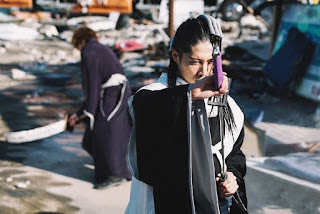'Bleach' premiered in the US last weekend, and it could pave the way forward for better representation of anime on the big screen.
Anime is cool now, but with its rise in Western culture, an awkward trend has followed of Hollywood trying to capitalize on anime fans with big-budget remakes of their beloved franchises. The streets of Los Angeles run with the fiscal blood of commercial and critical failures like Dragon Ball: Evolution and 2017's Ghost in the Shell. M. Night Shyamalan's Avatar: The Last Airbenderremake—itself drawing from a US-based riff on anime style—is a synonym for “bad movie.”
All of this is to say that, adapting the dynamic, inventive, reality-bending medium of anime to a live-action format is really hard. So appreciate it when I tell you that this weekend I saw the US debut of the new live-action adaptation ofBleach, one of the most popular anime and manga series of all time, and it was good.
Bleach is loved for its artsy, high concept fights between absurdly stubborn characters using large swords. It follows 15-year-old Ichigo Kurosaki, who’s thrust into a magical world when a ghostly Soul Reaper named Rukia Kuchiki gets injured and transfers her powers to him. Reapers shepherd the dead to the next world and keep corrupted spirits called Hollows from feasting on the souls of the living. They train for centuries to develop inhuman reflexes and turn their swords into highly customizable superweapons called zanpakuto. Ichigo uses Rukia’s power to protect her, his sisters, and his single father from a Hollow gone wild, but the Reaper is unable to retrieve her powers afterward. She’s stranded in the human world, masquerading as a normal high schooler, which kicks off the series.
Director Shinsuke Sato’s new film compresses all this information, plus the basic events of 19 more episodes of anime, into an easily digestable 90-minute slugfest. It's really incredible to watch. The decked-out costumes look dope, the action is surprisingly believable given the girth of the weapons, and the acting expertly mirrors anime's variance between stoic deadpan and over-the-top emotion.
That Sato's film is successful isn’t just my opinion, but based on observation of the packed theater full of fans who laughed at the jokes, gasped during the fights, and cheered when Ichigo and each of his friends—and enemies—were introduced. Everyone I spoke to after the screening was thrilled. “All of the reactions I wanted the audience to have, they provided for me,” Sato said through a translator during a post-film Q&A at the Japan Society’s annual film festival, Japan Cuts.
Kim Kindya a 49-year-old freelance writer and editor who sat behind me during the film, agrees with Tatara’s sentiment. “Bleach captured the spirit of the anime and the manga. It was a respectful adaptation,” she told me.
A 27-year-old library assistant named Chris, who chose not to provide his last name, said, “Certain creative risks, be they in casting or writing or directorial decisions, can ruin my experience as a fan. You don’t have to keep everything, but Bleach kept a lot.”
Noelle Webster, a 28-year-old Marvel employee who attended the screening, said, “Moving from an anime to a live-action is about making it feel more realistic. You have to ground that story in some sort of reality. Taking a fantastical story and making it more believable but also keeping that fun superhero sort of vibe is difficult, so it’s not always done well.” Kristina Winters, a 37-year-old sales consultant, added, “They kept to the core of the two main characters and kept it simple.”
Outside of the theater, nerd news standards have praised the film as not only good, but good for the whole world of live-action anime. Even the creator of the original Bleach manga was happy with the adaptation.
This is a stark contrast to Ghost in the Shell, for example, which received criticism for inauthenticity beyond the cardinal sin of whitewashing its source material. Emily Yoshida wrote for Vulture that the movie, “is obsessed with idea that Major ‘Mira’ must unlock her true individuality to defeat the system, an extraordinarily American narrative shoddily grafted onto the original story...The filmmakers think little of the emotional and intellectual connection fans already have with this property, and have put all their chips on the aesthetic. It’s exhausting to watch them curate what parts of the story’s Japanese origin are worth keeping and which can be discarded.”
There are eight Ghost in the Shell anime films, four video games, three anime series, and three books. Despite this wealth of inspiration, no one is clamoring for a follow up to its live-action adaptation. However, one of the most applauded questions at this screening was, “Do you want to do a sequel in the future?”
“A sequel is something I’d really like to do, and if it’s something the fans are wanting, I’d like to talk to my producer about it,“ said Sato. The fans went wild.
Information about further screenings of the Warner Bros. Japan-distributed film is to be determined, but you can watch the Bleach anime on Netflix, Hulu, Crunchyroll, and more.
Sign up for our newsletter to get the best of VICE delivered to your inbox daily.





No comments:
Post a Comment